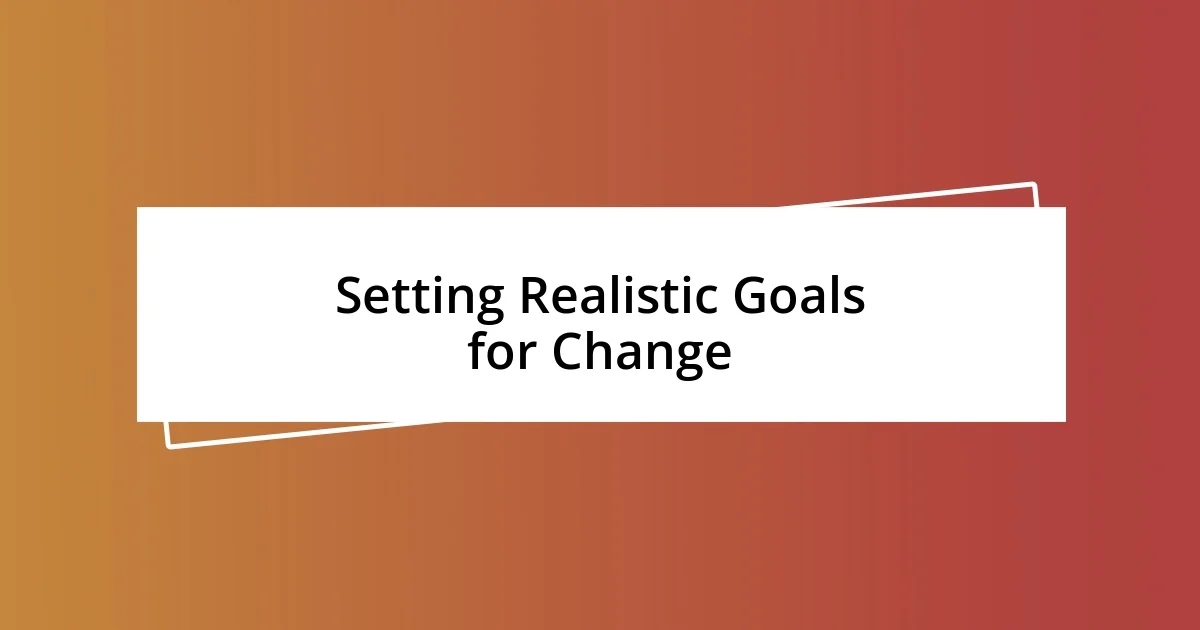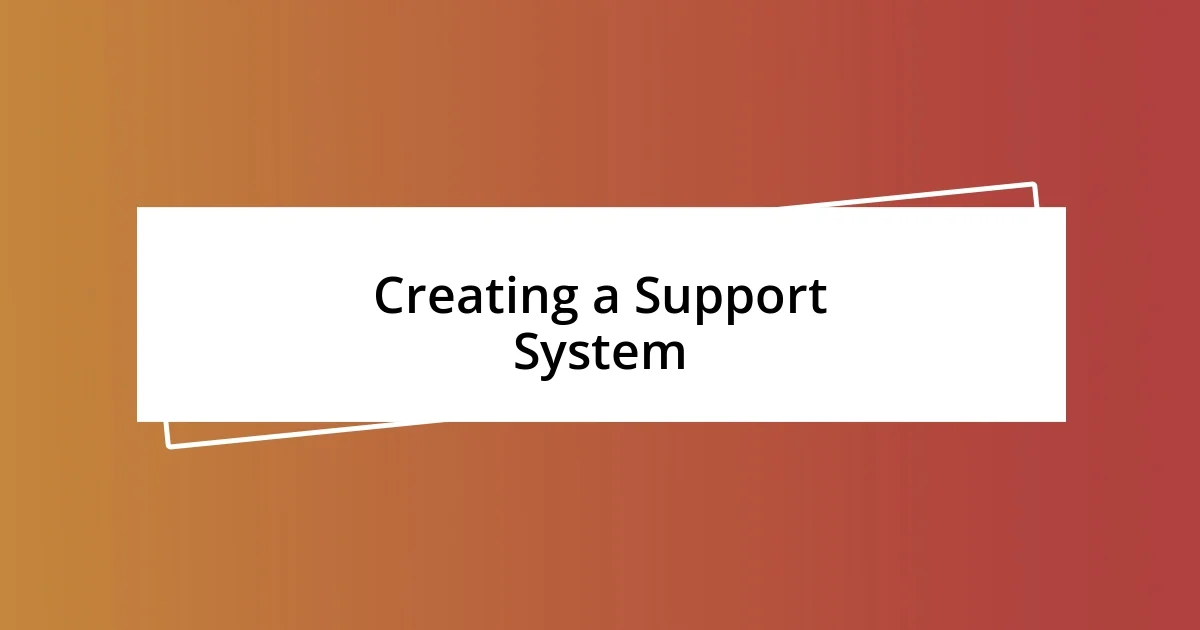Key takeaways:
- Recognizing the need for change can ignite personal growth by prompting self-reflection and reassessing priorities during challenging times.
- Identifying resistance to change involves acknowledging fears, avoidance behaviors, and procrastination that hinder progress.
- Creating a support system and maintaining commitment through small, realistic goals enhances resilience and fosters a positive mindset throughout the change journey.

Understanding the Need for Change
Change is often uncomfortable, but recognizing its necessity can be a powerful motivator. I remember a time when I felt completely stagnant in my job. Every day felt repetitive, and I found myself daydreaming about the opportunities I was missing. It made me question, “Is this really what I want for my life?” Embracing that question led me to explore new avenues, which ultimately enriched my life.
Change can also serve as a catalyst for personal growth. When faced with a challenging event, such as a breakup or losing a job, it’s easy to feel overwhelmed. I still recall the heartache I experienced during that period. Yet, looking back, I realize that it was a chance to reassess my priorities and understand what I truly valued. Have you ever found yourself in a similar situation? Sometimes, it takes that initial sting of discomfort to ignite a transformative journey.
Understanding the need for change is about recognizing that stagnation can lead to dissatisfaction. I vividly recall standing in front of the mirror one morning, feeling as if I was undoubtedly stuck. It dawned on me that complacency breeds unhappiness. The realization lit a fire in me—this was my cue to take action, to step out of my comfort zone, and to embrace the shifts life was presenting. Isn’t it fascinating how a simple moment can change our perspective?

Identifying Your Resistance to Change
Identifying resistance to change can begin with self-reflection. I used to ignore those little twinges of discomfort whenever I faced a new challenge. It felt easier to stay in familiar routines, even if they weren’t serving me well. Recognizing that I was holding onto certain beliefs or fears was the first step in my journey. I had to ask myself, “Is this fear genuinely protecting me, or is it simply keeping me stuck?”
When exploring my own resistance, I found it helpful to note specific feelings and behaviors that surfaced. Here are some common indicators that I identified:
- Avoidance: Steering clear of situations that require change, like skipping a social event or neglecting a job opportunity.
- Rationalization: Justifying my current situation, telling myself it’s “good enough” to avoid facing uncertainty.
- Anxiety: Experiencing a knot in my stomach or racing thoughts whenever considering a change, indicating deep-rooted fears.
- Procrastination: Putting off decisions or actions that could lead to change, often leading to missed opportunities.
- Complaining: Voicing dissatisfaction about my life without taking steps to improve it, revealing a desire for something different while resisting the necessary actions.
Recognizing these signs opened my eyes. It’s like shedding layers of skin—I felt lighter, more aware, and ready to take on life’s challenges.

Setting Realistic Goals for Change
Setting realistic goals is crucial when embracing change. From my experience, setting achievable milestones prevents feelings of overwhelm. For instance, instead of vowing to overhaul my entire career in one fell swoop, I opted to take small courses that aligned with my interests. By focusing on bite-sized goals, I slowly built the confidence necessary to pursue larger transitions.
Another key point is to ensure your goals are specific and measurable. I learned the hard way that vague intentions, like “I want to be healthier,” didn’t foster real change. Instead, defining actionable steps, such as committing to exercise three times a week or preparing meals at home, provided clarity. This approach not only kept my motivation high but also allowed me to track my progress, making the journey feel rewarding.
I often find it helpful to consider potential obstacles. Have you ever set a goal and felt discouragement midway? I certainly have. By anticipating challenges—like time constraints or external pressures—I could devise strategies to overcome them. This foresight turned potential setbacks into manageable hurdles, reinforcing the importance of resilience in pursuing change.
| Characteristic | Example |
|---|---|
| General Goal | “I want to be fit.” |
| Realistic Goal | “I will walk for 30 minutes at least 5 times a week.” |

Developing a Positive Mindset
When I think about developing a positive mindset, I can’t help but recall a time when I faced a particularly daunting change. It was during a job transition that felt overwhelming and filled with uncertainty. I had to shift my perspective, actively choosing to see this as an opportunity rather than a setback. Embracing optimism didn’t mean ignoring reality; it meant believing in my ability to adapt and grow. Have you ever caught yourself wallowing in doubt? I did, but acknowledging that inner dialogue was a game changer.
Practicing gratitude has been essential for me in cultivating a positive mindset. Each day, I began jotting down three things I was thankful for, no matter how small. Whether it was a delicious cup of coffee or a supportive friend, these moments helped me focus on the good. I found that shifting my thoughts, even slightly, created a ripple effect throughout my day. Have you ever tried keeping a gratitude journal? It’s amazing how these small acts can transform your outlook.
Furthermore, surrounding myself with positive influences made a significant difference. I used to be a sponge for negativity, but I discovered that engaging with uplifting content—like motivational podcasts or inspiring books—served as a balm for my worries. It reinforced that positivity is often a choice, influenced by our environment. Have you ever considered the impact of your social circle on your mindset? Reflecting on this helped me deliberately choose who I invested my time with, ultimately leading to a richer, more positive life experience.

Creating a Support System
Creating a support system has been a game changer for me during times of change. One of my favorite experiences was when I reached out to a close friend who had also undergone a major life transition. I’ll never forget how uplifting our conversations were—they weren’t just chats about the weather or daily routines. We shared our fears, hopes, and strategies. It felt like building a fortress of understanding around me, one that made me feel less isolated.
I also learned the value of expanding my circle. By attending local meetups and workshops, I met people who were navigating similar changes. At one event, I connected with a kindred spirit who inspired me to pursue a passion I had shelved for years. Can you imagine being in a room full of individuals who understand your struggles? It’s comforting and empowering, reminding me that we’re all in this together.
Ever considered the role of online communities? I stumbled upon an online forum dedicated to personal growth and change, and it was like finding a treasure chest of support. I remember sharing my own story and receiving encouraging replies that flooded in like a warm wave. It made me realize that no matter where we are, we can always find people who resonate with our experiences. This digital support network has not only given me guidance but also the confidence to embrace my own journey, knowing there are others walking a similar path.

Taking Action and Staying Committed
Taking action and staying committed was an essential part of my journey. I remember vividly the decision to join a fitness class after years of neglecting my health. It wasn’t easy to step outside my comfort zone, but I knew it was a step I had to take for my well-being. Have you ever pushed yourself to try something challenging? That initial awkwardness faded quickly as I embraced the routine, each class building not just my strength but also my resolve.
One powerful lesson I learned was about the importance of consistency. At first, it felt tedious to stick to a schedule, but I soon realized that commitment meant showing up for myself, even on days when I wasn’t feeling motivated. I would often remind myself of my goals, finding inspiration in the small changes I noticed over time. Isn’t it fascinating how persistence can create transformations we never thought possible? Knowing that each effort was shaping my future made it easier to keep going.
I also discovered the value of celebrating progress, however small it seemed. After completing my first month of consistent workouts, I treated myself to a new workout outfit, something that made me feel good and acknowledged my efforts. This practice kept the momentum going, reinforcing the idea that taking action is one part of the equation, but staying committed is what truly drives lasting change. Have you found ways to reward yourself during your journey? It’s a simple yet effective method for keeping the fire of commitment alive.

Reflecting on Your Growth Journey
Reflecting on my growth journey feels like leafing through the chapters of my own story. Each time I look back, I notice how far I’ve come, often surprising myself with the resilience I didn’t know I had. Have you ever paused to think about the little victories you’ve achieved along the way? These moments, though sometimes overshadowed by my challenges, serve as a reminder that growth isn’t always about grand gestures; it’s in the quiet, persistent steps we take.
One moment that sticks with me is when I faced a significant setback and felt like I was back at square one. I remember sitting down, acknowledging my feelings of disappointment, and then flipping the narrative in my mind. Instead of viewing it as a failure, I began to see it as a crucial part of my learning curve. This perspective shift can be powerful, don’t you think? Realizing that setbacks are just setups for comebacks reassured me that my journey is more like a winding path than a straight line.
As I continue to reflect, I’m filled with gratitude for the lessons learned. Each challenge has carved out a deeper understanding of myself. I often ask myself, what would I tell my past self if I could? Perhaps it would be to embrace the uncertainty and trust the process. I’ve come to appreciate that growth isn’t always visible, but it’s happening within us—gradually shaping who we are becoming. Isn’t it fascinating how our experiences can deepen our connection with ourselves? Reflecting on these elements reminds me that the journey itself is a beautiful tapestry we weave over time.













